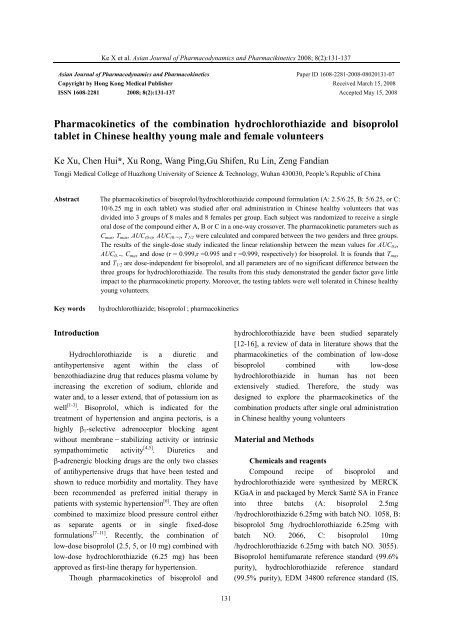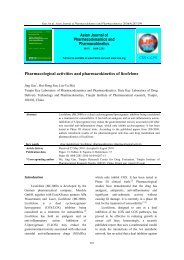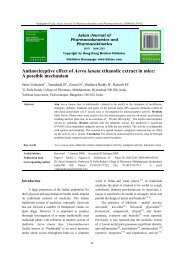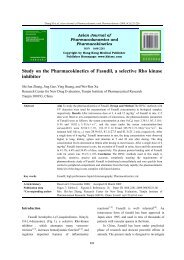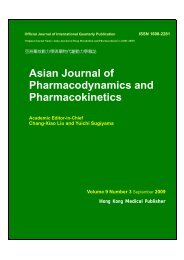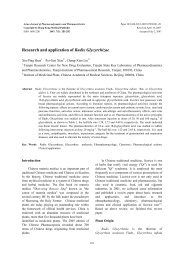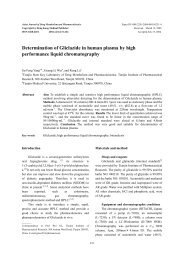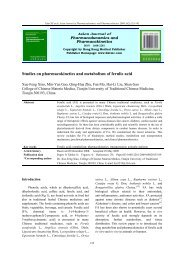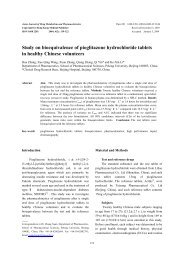Pharmacokinetics of the combination hydrochlorothiazide and ...
Pharmacokinetics of the combination hydrochlorothiazide and ...
Pharmacokinetics of the combination hydrochlorothiazide and ...
You also want an ePaper? Increase the reach of your titles
YUMPU automatically turns print PDFs into web optimized ePapers that Google loves.
Ke X et al. Asian Journal <strong>of</strong> Pharmacodynamics <strong>and</strong> Pharmacikinetics 2008; 8(2):131-137<br />
Asian Journal <strong>of</strong> Pharmacodynamics <strong>and</strong> <strong>Pharmacokinetics</strong> Paper ID 1608-2281-2008-08020131-07<br />
Copyright by Hong Kong Medical Publisher Received March 15, 2008<br />
ISSN 1608-2281 2008; 8(2):131-137 Accepted May 15, 2008<br />
<strong>Pharmacokinetics</strong> <strong>of</strong> <strong>the</strong> <strong>combination</strong> <strong>hydrochlorothiazide</strong> <strong>and</strong> bisoprolol<br />
tablet in Chinese healthy young male <strong>and</strong> female volunteers<br />
Ke Xu, Chen Hui*, Xu Rong, Wang Ping,Gu Shifen, Ru Lin, Zeng F<strong>and</strong>ian<br />
Tongji Medical College <strong>of</strong> Huazhong University <strong>of</strong> Science & Technology, Wuhan 430030, People’s Republic <strong>of</strong> China<br />
Abstract The pharmacokinetics <strong>of</strong> bisoprolol/<strong>hydrochlorothiazide</strong> compound formulation (A: 2.5/6.25, B: 5/6.25, or C:<br />
10/6.25 mg in each tablet) was studied after oral administration in Chinese healthy volunteers that was<br />
divided into 3 groups <strong>of</strong> 8 males <strong>and</strong> 8 females per group. Each subject was r<strong>and</strong>omized to receive a single<br />
oral dose <strong>of</strong> <strong>the</strong> compound ei<strong>the</strong>r A, B or C in a one-way crossover. The pharmacokinetic parameters such as<br />
C max, T max, AUC (0-t), AUC (0-∞), T 1/2 were calculated <strong>and</strong> compared between <strong>the</strong> two genders <strong>and</strong> three groups.<br />
The results <strong>of</strong> <strong>the</strong> single-dose study indicated <strong>the</strong> linear relationship between <strong>the</strong> mean values for AUC 0-t,<br />
AUC 0-∞, C max <strong>and</strong> dose (r = 0.999,r =0.995 <strong>and</strong> r =0.999, respectively) for bisoprolol. It is founds that T max<br />
<strong>and</strong> T 1/2 are dose-independent for bisoprolol, <strong>and</strong> all parameters are <strong>of</strong> no significant difference between <strong>the</strong><br />
three groups for <strong>hydrochlorothiazide</strong>. The results from this study demonstrated <strong>the</strong> gender factor gave little<br />
impact to <strong>the</strong> pharmacokinetic property. Moreover, <strong>the</strong> testing tablets were well tolerated in Chinese healthy<br />
young volunteers.<br />
Key words <strong>hydrochlorothiazide</strong>; bisoprolol ; pharmacokinetics<br />
Introduction<br />
Hydrochlorothiazide is a diuretic <strong>and</strong><br />
antihypertensive agent within <strong>the</strong> class <strong>of</strong><br />
benzothiadiazine drug that reduces plasma volume by<br />
increasing <strong>the</strong> excretion <strong>of</strong> sodium, chloride <strong>and</strong><br />
water <strong>and</strong>, to a lesser extend, that <strong>of</strong> potassium ion as<br />
well [1-3] . Bisoprolol, which is indicated for <strong>the</strong><br />
treatment <strong>of</strong> hypertension <strong>and</strong> angina pectoris, is a<br />
highly β1-selective adrenoceptor blocking agent<br />
without membrane-stabilizing activity or intrinsic<br />
sympathomimetic activity [4,5] . Diuretics <strong>and</strong><br />
β-adrenergic blocking drugs are <strong>the</strong> only two classes<br />
<strong>of</strong> antihypertensive drugs that have been tested <strong>and</strong><br />
shown to reduce morbidity <strong>and</strong> mortality. They have<br />
been recommended as preferred initial <strong>the</strong>rapy in<br />
patients with systemic hypertension [6] . They are <strong>of</strong>ten<br />
combined to maximize blood pressure control ei<strong>the</strong>r<br />
as separate agents or in single fixed-dose<br />
formulations [7–11] . Recently, <strong>the</strong> <strong>combination</strong> <strong>of</strong><br />
low-dose bisoprolol (2.5, 5, or 10 mg) combined with<br />
low-dose <strong>hydrochlorothiazide</strong> (6.25 mg) has been<br />
approved as first-line <strong>the</strong>rapy for hypertension.<br />
Though pharmacokinetics <strong>of</strong> bisoprolol <strong>and</strong><br />
131<br />
<strong>hydrochlorothiazide</strong> have been studied separately<br />
[12-16], a review <strong>of</strong> data in literature shows that <strong>the</strong><br />
pharmacokinetics <strong>of</strong> <strong>the</strong> <strong>combination</strong> <strong>of</strong> low-dose<br />
bisoprolol combined with low-dose<br />
<strong>hydrochlorothiazide</strong> in human has not been<br />
extensively studied. Therefore, <strong>the</strong> study was<br />
designed to explore <strong>the</strong> pharmacokinetics <strong>of</strong> <strong>the</strong><br />
<strong>combination</strong> products after single oral administration<br />
in Chinese healthy young volunteers<br />
Material <strong>and</strong> Methods<br />
Chemicals <strong>and</strong> reagents<br />
Compound recipe <strong>of</strong> bisoprolol <strong>and</strong><br />
<strong>hydrochlorothiazide</strong> were syn<strong>the</strong>sized by MERCK<br />
KGaA in <strong>and</strong> packaged by Merck Santé SA in France<br />
into three batchs (A: bisoprolol 2.5mg<br />
/<strong>hydrochlorothiazide</strong> 6.25mg with batch NO. 1058, B:<br />
bisoprolol 5mg /<strong>hydrochlorothiazide</strong> 6.25mg with<br />
batch NO. 2066, C: bisoprolol 10mg<br />
/<strong>hydrochlorothiazide</strong> 6.25mg with batch NO. 3055).<br />
Bisoprolol hemifumarate reference st<strong>and</strong>ard (99.6%<br />
purity), <strong>hydrochlorothiazide</strong> reference st<strong>and</strong>ard<br />
(99.5% purity), EDM 34800 reference st<strong>and</strong>ard (IS,
Ke X et al. Asian Journal <strong>of</strong> Pharmacodynamics <strong>and</strong> Pharmacikinetics 2008; 8(2):131-137<br />
98.5% purity)<strong>and</strong> hydr<strong>of</strong>lumethiazide reference<br />
st<strong>and</strong>ard (IS, 97% purity) were supplied by MERCK<br />
KGaA (German). Purified water from a Milli-Q<br />
system (Millipore, Bedford, MA, USA) was used<br />
throughout. The control human plasma was<br />
purchased from Blood Bank (Tongji Hospital, Wuhan,<br />
China). HPLC grade acetonitrile, methanol was<br />
purchased from Merk (German). All o<strong>the</strong>r chemicals<br />
were <strong>of</strong> analytical grade.<br />
Study design<br />
In accordance with <strong>the</strong> Declamtion <strong>of</strong> Helsinki,<br />
all volunteers who had been told <strong>the</strong> aim <strong>and</strong> risk <strong>of</strong><br />
<strong>the</strong> study gave <strong>the</strong>ir written consent to <strong>the</strong>ir<br />
participation in <strong>the</strong> study, <strong>and</strong> <strong>the</strong> protocol was<br />
approved by an Institutional Review Board <strong>of</strong> Tongji<br />
Medical College <strong>of</strong> Huazhong University <strong>of</strong> Science<br />
& Technology.<br />
The study was conducted as a single-dose,<br />
open-label, r<strong>and</strong>omized study in 48 Chinese healthy<br />
volunteers (M 24, F 24, age 19–27 years, body mass<br />
index between 18.6 <strong>and</strong> 23.3) that was divided into 3<br />
groups <strong>of</strong> 8 male <strong>and</strong> 8 female per group. All <strong>the</strong><br />
mean demographic data <strong>of</strong> age, height <strong>and</strong> weight <strong>of</strong><br />
volunteers are summarized in Table 1. All subjects<br />
passed complete physical examination, revealing no<br />
clinically relevant hepatic, renal, cardiac,<br />
hematologic, or o<strong>the</strong>r diseases, <strong>and</strong> all had no o<strong>the</strong>r<br />
drugs two weeks before <strong>and</strong> during <strong>the</strong> study. A<br />
st<strong>and</strong>ardized meal was served. Cigarettes <strong>and</strong> alcohol<br />
were restrained. Volunteers were provided with<br />
st<strong>and</strong>ard diet 3 times per day. Each group received<br />
single oral drug A, B, or C a tablet toge<strong>the</strong>r with 200<br />
ml water respectively. During <strong>the</strong> whole study course,<br />
subjects were instructed by <strong>the</strong> investigator to report<br />
immediately <strong>the</strong> occurrence <strong>of</strong> any adverse event.<br />
After completing <strong>the</strong> study, all subjects received<br />
complete physical examination.<br />
Sample collection<br />
Blood samples were drawn predose <strong>and</strong> 20min,<br />
40min <strong>and</strong> 1, 1.5, 2, 3, 4, 6, 8, 12, 16, 24, 36 <strong>and</strong> 48 h<br />
postdose (6 ml each time). After centrifugation, <strong>the</strong><br />
plasma was isolated <strong>and</strong> stored at -20 ℃ until analysis.<br />
Vital sign examination was taken predose <strong>and</strong> 1, 2, 4,<br />
8, 24 <strong>and</strong> 48 h postdose.<br />
Chromatographic analysis<br />
132<br />
After adding <strong>the</strong> internal st<strong>and</strong>ard, bisoprolol<br />
plasma samples were adjusted to proper PH with<br />
saturated natronite <strong>and</strong> were precipitated using<br />
pentane-dichloromethane, 70:30(v/v), <strong>and</strong> <strong>the</strong>n were<br />
freezing at -60°C~-70°C. The water layer separated<br />
from <strong>the</strong> clear supernatant was melting to room<br />
temperature <strong>and</strong> injected into a integrated HPLC<br />
system (LC1100 Agilent, Hewlett-Packard, USA)<br />
equipped with a quaternary pump, a degasser, an<br />
auto-sampler, an injector with a 50-μL loop, a column<br />
oven , a UV detector (set as 271nm) <strong>and</strong> a data<br />
system (Agilent ChemStation). As to<br />
<strong>hydrochlorothiazide</strong> plasma samples,<br />
<strong>hydrochlorothiazide</strong> <strong>and</strong> IS were extract by methyl<br />
tert-butyl e<strong>the</strong>r (MTBE). The extract was dried under<br />
nitrogen <strong>and</strong> analyzed by <strong>the</strong> same HPLC system<br />
with a fluorescence detector (setting as EX:225nm<br />
<strong>and</strong> EM : 300nm). The data were acquired <strong>and</strong><br />
processed with <strong>the</strong> 3P97 s<strong>of</strong>tware package (The<br />
Ma<strong>the</strong>matics Pharmacology Committee, Chinese<br />
Pharmacological Society) <strong>and</strong> SAS 8.02 (Carey,<br />
North Carolina, USA).<br />
The assay method was validated with respect to<br />
accuracy, precision, linearity, sensitivity, <strong>and</strong><br />
specificity. The st<strong>and</strong>ard calibration curves were<br />
linear over <strong>the</strong> concentration range 0.5–50 ng·mL -1<br />
for bisoprolol <strong>and</strong> 2–75 ng·mL -1 for<br />
<strong>hydrochlorothiazide</strong>. The accuracy <strong>and</strong> precision <strong>of</strong><br />
this method was examined using human plasma<br />
freshly prepared at <strong>hydrochlorothiazide</strong><br />
concentrations <strong>of</strong> 3, 35, 70 ng·mL -1 <strong>and</strong> at bisoprolol<br />
concentrations <strong>of</strong> 0.7, 20, 45 ng·mL -1 , which had<br />
coefficients <strong>of</strong> variation less than or equal to 7.2%<br />
<strong>and</strong> 8.35%, respectively.<br />
Pharmacokinetic analysis<br />
Pharmacokinetic parameters were calculated by<br />
employing st<strong>and</strong>ard non-compartmental analysis<br />
(Gibaldi <strong>and</strong> Perrier, 1982) <strong>and</strong> using Practical<br />
Pharmacokinetic Program 3P97 (Math-pharmacology<br />
Committee, Chinese Academy <strong>of</strong> Pharmacology,<br />
Beijing, China). The peak plasma concentration (Cmax)<br />
<strong>and</strong> <strong>the</strong> corresponding time (Tmax) were directly<br />
obtained from <strong>the</strong> raw data. The area under <strong>the</strong><br />
plasma concentration vs time curve up to <strong>the</strong> last<br />
quantifiable time point(AUC(0−t)) was obtained by<br />
<strong>the</strong> linear <strong>and</strong> log–linear trapezoidal summation. The<br />
AUC(0−t) extrapolated to infinity (i.e. AUC(0−∞)) by
Ke X et al. Asian Journal <strong>of</strong> Pharmacodynamics <strong>and</strong> Pharmacikinetics 2008; 8(2):131-137<br />
adding <strong>the</strong> quotient <strong>of</strong> Clast/Kel, where Clast represents<br />
<strong>the</strong> last measurable time concentration <strong>and</strong> Kel<br />
represents <strong>the</strong> apparent terminal rate constant. Kel<br />
was calculated by <strong>the</strong> linear regression <strong>of</strong> <strong>the</strong><br />
log-transformed concentrations <strong>of</strong> <strong>the</strong> drug in <strong>the</strong><br />
133<br />
terminal phase. The half-life (t1/2) <strong>of</strong> <strong>the</strong> terminal<br />
elimination phase was obtained using <strong>the</strong> relationship<br />
t1/2 = 0.693/Kel.<br />
Table 1. Mean demographic data for subjects (n =48)<br />
A B C<br />
Male (8) Female (8) Male (8) Female (8) Male (8) Female (8)<br />
Year (y) 23.0±2.3 21.4±1.7 22.1±1.0 21.1±1.7 23.6±1.7 22.9±2.1<br />
Weight (kg) 59.6±6.5 52.7±3.5 55.8±5.3 50.0±4.8 59.0±5.4 52.2±5.6<br />
Height (cm) 168.7±6.7 159.1±4.6 167.1±6.5 155.4±4.0 169.6±7.0 157.8±5.9<br />
BMI 20.9±1.2 20.8±0.6 20.0±1.3 20.7±1.5 20.5±1.6 20.9±1.2<br />
Table 2. Pharmacokinetic parameters <strong>of</strong> 48 health Chinese volunteers after oral administration<br />
<strong>of</strong> compound <strong>hydrochlorothiazide</strong> <strong>and</strong> bisoprolol tablets (n = 48) (n=8, mean±SD)<br />
PK parameters<br />
bisoprolol <strong>hydrochlorothiazide</strong><br />
A B C A B C<br />
AUC 0-tlast(ng·h·ml -1 ) 200.2±35.4 414.3±102.7 914.8±190.9 264.4±97.8 254.3±58.8 257.4±52.6<br />
AUC 0-inf(ng·h·ml -1 ) 213.8±38.4 431.7±112.2 946.6±216.6 296.0±110.6 275.7±60.2 280.1±55.3<br />
C max(ng·ml -1 ) 14.4±2.2 30.0±5.3 65.8±13.8 47.3±10.0 48.5±8.8 46.4±10.0<br />
Tmax (h) 2.4±0.9 2.4±1.0 2.4±0.9 2.1±0.6 2.1±0.6 1.9±0.4<br />
T 1/2(h) 10.5±2.7 9.2±1.4 9.2±1.7 5.9±1.7 5.1±1.7 5.0±1.6<br />
Vd (L·kg -1 ) 3.2±0.8 3.1±0.7 2.6±0.4 2.6±0.5 2.4±0.7 2.8±1.0<br />
Table 3. Pharmacokinetic parameters <strong>of</strong> bisoprolol in healthy male <strong>and</strong> female volunteers<br />
Parameter A B C<br />
Male Female Male Female Male Female<br />
C max(ng·ml -1 ) 13.5±2.7 15.2±1.3 29.0±6.6 31.0±4.0 66.0±14.0 65.6±14.5<br />
T max(h) 2.2±0.7 2.6±1.0 2.4±0.9 2.4±1.2 2.5±0.9 2.3±0.9<br />
AUC (o-t)( ng·h·ml -1 ) 178.1±24.6 222.3±31.1 370.2±80.3 458.4±108.1 902.6±177.7 927.0±214.9<br />
AUC (0-∞)(ng·h·ml -1 ) 191.2±28.1 236.4±34.7 385.8±88.8 477.5±119.4 932.9±206.6 960.3±239.5<br />
T1/2(h) 10.8±2.6 10.1±3.0 9.7±1.6 8.7±0.9 9.0±1.9 9.4±1.5<br />
Table 4. Pharmacokinetic parameters <strong>of</strong> <strong>hydrochlorothiazide</strong> in healthy male <strong>and</strong> female volunteers( n=8, mean±SD)<br />
Parameter A B C<br />
Male Female Male Female Male Female<br />
Cmax(ng·ml -1 ) 41.5±8.6 53.1±8.8 43.2±5.0 53.9±8.8 40.4±8.1 52.5±8.2<br />
T max(h) 2.0±0.7 2.3±0.7 2.3±0.6 1.9±0.6 2.1±0.4 1.8±0.4<br />
AUC (o-t)( ng·h·ml -1 )) 215.1±52.7 313.8±116.2 225.0±46.5 283.6±57.4 238.1±56.7 276.6±43.2<br />
AUC (0-∞)( ng·h·ml -1 )) 242.6±52.9 349.3±136.6 248.5±51.7 302.9±58.3 264.7±62.1 295.5±46.6<br />
T1/2(h) 5.7±0.9 6.0±2.4 5.9±1.7 4.2±1.2 5.7±1.7 4.3±1.1
Ke X et al. Asian Journal <strong>of</strong> Pharmacodynamics <strong>and</strong> Pharmacikinetics 2008; 8(2):131-137<br />
Fig 1. Individual plasma concentration-time pr<strong>of</strong>iles <strong>of</strong> bisoprolol (1) <strong>and</strong> <strong>hydrochlorothiazide</strong> (2) in healthy male <strong>and</strong> female<br />
Chinese young volunteers after oral administration one tablet <strong>of</strong> bisoprolol/<strong>hydrochlorothiazide</strong> <strong>combination</strong><br />
(A: 2.5/6.25, B: 5/6.25, or C: 10/6.25 mg/tablet).<br />
Fig 2. Mean plasma concentration-time pr<strong>of</strong>iles <strong>of</strong> bisoprolol <strong>and</strong> <strong>hydrochlorothiazide</strong> in healthy male <strong>and</strong> female Chinese<br />
young volunteers after single oral administration one tablet <strong>of</strong> bisoprolol/<strong>hydrochlorothiazide</strong> <strong>combination</strong><br />
(A: 2.5/6.25, B: 5/6.25, or C: 10/6.25 mg/tablet).<br />
Fig 3. Mean AUC 0-48, AUC 0-∞ or C max <strong>of</strong> bisoprolol versus dose after after single oral administration one tablet <strong>of</strong><br />
bisoprolol/<strong>hydrochlorothiazide</strong> <strong>combination</strong> (A: 2.5/6.25, B: 5/6.25, or C: 10/6.25 mg/tablet).<br />
134
Ke X et al. Asian Journal <strong>of</strong> Pharmacodynamics <strong>and</strong> Pharmacikinetics 2008; 8(2):131-137<br />
Fig 4. Mean plasma concentration-time pr<strong>of</strong>iles <strong>of</strong> bisoprolol (1) <strong>and</strong> <strong>hydrochlorothiazide</strong> (2) in healthy male <strong>and</strong> female<br />
Chinese young volunteers after oral administration one tablet <strong>of</strong> bisoprolol/<strong>hydrochlorothiazide</strong> <strong>combination</strong><br />
(A: 2.5/6.25, B: 5/6.25, or C: 10/6.25 mg/tablet).<br />
Statistical evaluation<br />
Data are expressed as mean±SD. An unpaired<br />
t-test with significance set at α=0.05 was used for all<br />
parameters to compare <strong>the</strong> pharmacokinetic<br />
parameters <strong>of</strong> bisoprolol <strong>and</strong> <strong>hydrochlorothiazide</strong> in<br />
males <strong>and</strong> females. And an analysis <strong>of</strong> variance<br />
(ANOVA) was used to examine a different in Tmax,<br />
T1/2 <strong>and</strong> dose-normalized AUC0-t, AUC0-∞ <strong>and</strong> Cmax<br />
for bisoprolol <strong>and</strong> <strong>hydrochlorothiazide</strong> across <strong>the</strong><br />
three doses. The p value
Ke X et al. Asian Journal <strong>of</strong> Pharmacodynamics <strong>and</strong> Pharmacikinetics 2008; 8(2):131-137<br />
was not possible to determine definitively if <strong>the</strong><br />
difference was real or due to <strong>the</strong> limited number <strong>of</strong><br />
subjects. There was little inter-variability between<br />
subjects when compound <strong>hydrochlorothiazide</strong> <strong>and</strong><br />
bisoprolol tablet was administered orally.<br />
Mean plasma concentration-time curves in both<br />
sexes are shown in Figure 4 <strong>and</strong> <strong>the</strong> related<br />
pharmacokinetic variables are summarized in Table 3<br />
<strong>and</strong> 4. There was no significant difference in all<br />
calculated pharmacokinetic parameters between <strong>the</strong><br />
male <strong>and</strong> female subjects (p>0.05).<br />
Tolerability<br />
In <strong>the</strong> whole study, We had only found that<br />
several adverse reactions, including headache,<br />
dizziness, chillsz h<strong>and</strong>s <strong>and</strong> sweats, were observed on<br />
four female volunteers,half after treatment with A<br />
<strong>and</strong> half after treatment with C.<br />
Discussion<br />
According <strong>the</strong> former study after oral<br />
administration in humans, bisoprolol is rapidly<br />
absorbed (tmax:2~3h)with an absorptivity <strong>of</strong> more<br />
than 90% <strong>and</strong> has an absolute bioavailability <strong>of</strong><br />
about 88% .The first pass metabolism <strong>of</strong> bisoprolol<br />
fumarate is about 20%. And <strong>the</strong> rate <strong>of</strong> plasma<br />
protein binding is about 30%. Hydrochlorothiazide is<br />
well absorbed (65%-75%) following oral<br />
administration <strong>and</strong> Cmax are observed within 1-5<br />
hours <strong>of</strong> dosing, ranging from 70-490 ng·ml -1<br />
following oral doses <strong>of</strong> 12.5-100 mg. Plasma<br />
concentrations are linearly related to <strong>the</strong> administered<br />
dose <strong>and</strong> 35-38% <strong>of</strong> <strong>the</strong> whole blood concentration.<br />
Hydrochlorothiazide is eliminated primarily by renal<br />
pathways <strong>and</strong> T1/2 has been reported to be 6-15<br />
hours [17] . The <strong>combination</strong> <strong>of</strong> bisoprolol <strong>and</strong><br />
<strong>hydrochlorothiazide</strong> was well tolerated, <strong>and</strong> overall<br />
quality-<strong>of</strong>-life questionnaire scores indicated an<br />
improvement after bisoprolol/<strong>hydrochlorothiazide</strong><br />
<strong>the</strong>rapy. The binary mixture <strong>of</strong> bisoprolol <strong>and</strong><br />
<strong>hydrochlorothiazide</strong> is widely used <strong>and</strong> studied in <strong>the</strong><br />
treatment <strong>of</strong> hypertension but still isn’t studied <strong>and</strong><br />
used on Chinese. To <strong>the</strong> best <strong>of</strong> our knowledge, few<br />
documents have been described for <strong>the</strong><br />
pharmacokinetics <strong>of</strong> <strong>the</strong> <strong>combination</strong> product <strong>of</strong> two<br />
drugs on Chinese. Therefore, it is necessary to<br />
136<br />
conduct <strong>the</strong> pharmacokinetic study for <strong>the</strong> drug using<br />
in Chinese. This technique can add general<br />
knowledge on pharmacokinetics with<br />
co-administration <strong>of</strong> compound hydrochlorothi- azide<br />
<strong>and</strong> bisoprolol tablets in 3 dosage groups on Chinese.<br />
Twenty-four female <strong>and</strong> twenty-four male<br />
adolescents enrolled in <strong>the</strong> study, complied with <strong>the</strong><br />
protocol <strong>and</strong> completed <strong>the</strong> required follow-up visits.<br />
All participants enrolled in <strong>the</strong> study completed <strong>the</strong><br />
protocol.<br />
Through use <strong>of</strong> <strong>the</strong> bridging study, <strong>the</strong><br />
international harmonization for new drug<br />
development makes extrapolation <strong>of</strong> foreign clinical<br />
trial data to a new region possible for new drug<br />
application. As a bridging study, this study can<br />
provide evidence for <strong>the</strong> investigational drug using in<br />
China. On <strong>the</strong> basis <strong>of</strong> results <strong>of</strong> pharmacokinetic<br />
study, all <strong>the</strong> pharmacokinetic parameters were<br />
similar to <strong>the</strong> result <strong>of</strong> clinical trial for <strong>the</strong> respective<br />
pharmacokinetics study [16] . Therefore, <strong>the</strong> study<br />
gives clue to <strong>the</strong> clinical use <strong>of</strong> <strong>the</strong> <strong>combination</strong> in<br />
Chinese patiens.<br />
References<br />
1. Vonaparti A, Kazanis M, P<strong>and</strong>eri I. Development <strong>and</strong><br />
validation <strong>of</strong> a liquid chromatographic/electrospray<br />
2.<br />
ionization mass spectrometric method for <strong>the</strong> determination<br />
<strong>of</strong> Benazepril, Benazeprilat <strong>and</strong> <strong>hydrochlorothiazide</strong> in<br />
human plasma. J Mass Spectrom 2006; 41: 593–605.<br />
Rahn K.H. Clinical pharmacology <strong>of</strong> diuretics. Clin Exp<br />
Hypertens 1983; 5(2):157–166.<br />
3. Patel RB, Patel UR, Rogge MC, Shah VP, Prasad VK, Selen<br />
A, Welling PG. Bioavailability <strong>of</strong> <strong>hydrochlorothiazide</strong> from<br />
tablets <strong>and</strong> suspensions. J Pharm Sci 1984; 73: 359–361.<br />
4. Schliep HJ, Harting J. β1-Selectivity <strong>of</strong> Bisoprolol, a New<br />
β-Adrenoceptor Antagonist, in Anes<strong>the</strong>tized Dogs <strong>and</strong><br />
Guinea Pigs. J Cardiovasc Pharmacol 1984; 6: 1156-1160.<br />
5. Dequattro V, Welt MR. Bisoprolol fumarate/<br />
6.<br />
Hydrochlorothiazide 6.25mg: a new low-dose option for<br />
first-line antihypertensive <strong>the</strong>rapy. Adv Ther 1993; 100:<br />
197-206.<br />
The Joint National Committee on Detection, Evaluation <strong>and</strong><br />
Treatment <strong>of</strong> High Blood Pressure: The Fifth Report <strong>of</strong> <strong>the</strong><br />
Joint National Committee on Detection, Evaluation <strong>and</strong><br />
Treatment <strong>of</strong> High Blood Pressure (JNCV). Arch intern Med<br />
1993; 153:154-183.<br />
7. Townsend RR, Holl<strong>and</strong> OB. Combination <strong>of</strong> converting<br />
enzyme inhibitor with diuretic for <strong>the</strong> treatment <strong>of</strong><br />
hypertension. Arch Intern Med 1990; 150: 1175–1183.<br />
8. Simpson FO. Combination <strong>the</strong>rapy in hypertension. Drugs<br />
1980; 20: 69–73.<br />
9. Enlund H, Turakka H, Tuomilehto J. Combination <strong>the</strong>rapy in
Ke X et al. Asian Journal <strong>of</strong> Pharmacodynamics <strong>and</strong> Pharmacikinetics 2008; 8(2):131-137<br />
10.<br />
hypertension. Eur J Clin Pharmacol 1981; 21: 1–8.<br />
Shenfield GM. Fixed <strong>combination</strong> drug <strong>the</strong>rapy. Drugs 1982;<br />
23: 462-480.<br />
11. Oiosntesr JR, Epstein M: Fix-dose <strong>combination</strong> medication<br />
for <strong>the</strong> treatmend <strong>of</strong> hypertension: a critical review. J Clin<br />
Hypertens 1987; 3: 178–193.<br />
12. Kirch W, Rose I, Demers HG, Leopold G, Pabst J, Ohnhaus<br />
EE. <strong>Pharmacokinetics</strong> <strong>of</strong> Bisoprolol during repeated oral<br />
administration to healthy volunteers <strong>and</strong> patients with<br />
kidney or liver diseases. Clin Pharmacokinet 1987;<br />
13:110-117<br />
13. Leopold G, Pabst J, Ungethum W, Buhring K.U. Basic<br />
pharmacokinetics <strong>of</strong> Bisoprolol, a new highly B1-selective<br />
adrenoceptor<br />
26:616-621.<br />
antagonist. J Clin Pharmacol 1986;<br />
14. Leopold G. Balanced pharmacokinetics <strong>and</strong> metabolism <strong>of</strong><br />
Bisoprolol. J Cardiovasc Pharmacol 1986; 8 (Suppl 11): S<br />
16.b<br />
15. Farthing D, Fakhry I, Elizabeth B. D. Ripley, Sica D. Simple<br />
method for determination <strong>of</strong> <strong>hydrochlorothiazide</strong> in human<br />
137<br />
16.<br />
urine by high performance liquid chromatography utilizing<br />
narrowbore chromatography. J Pharmaceut Biomed 1998;<br />
17:1455–1459.<br />
Liu F, Xu Y, Gao S, Zhang JD, Guo QX. Determination <strong>of</strong><br />
<strong>hydrochlorothiazide</strong> in human plasma by liquid<br />
chromatography/t<strong>and</strong>em mass spectrometry. J Pharmaceut<br />
Biomed 2007; 44:1187–1191.<br />
17. The RxList websit: http://www.rxlist.com/cgi/<br />
18.<br />
generic/bishctz_ids.htm/[8 November 2007].<br />
Liu MY, Zhang D, Sun YT, Wang YW, Gu JK. Liquid<br />
chromatographic-electrospray t<strong>and</strong>em mass spectrometric<br />
determination <strong>of</strong> bisoprolol in human plasma. Biomed<br />
Chromatogr 2007; 21: 508-51<br />
*Correspondence to:Hangkong Road 13, Department <strong>of</strong><br />
clinical pharmacology, Tongji Medical College <strong>of</strong> Huazhong<br />
University <strong>of</strong> Science & Technology at Wuhan, Hubei, China.<br />
E-mail:chenhuitjmu@163.com,Tele: 02783657947


